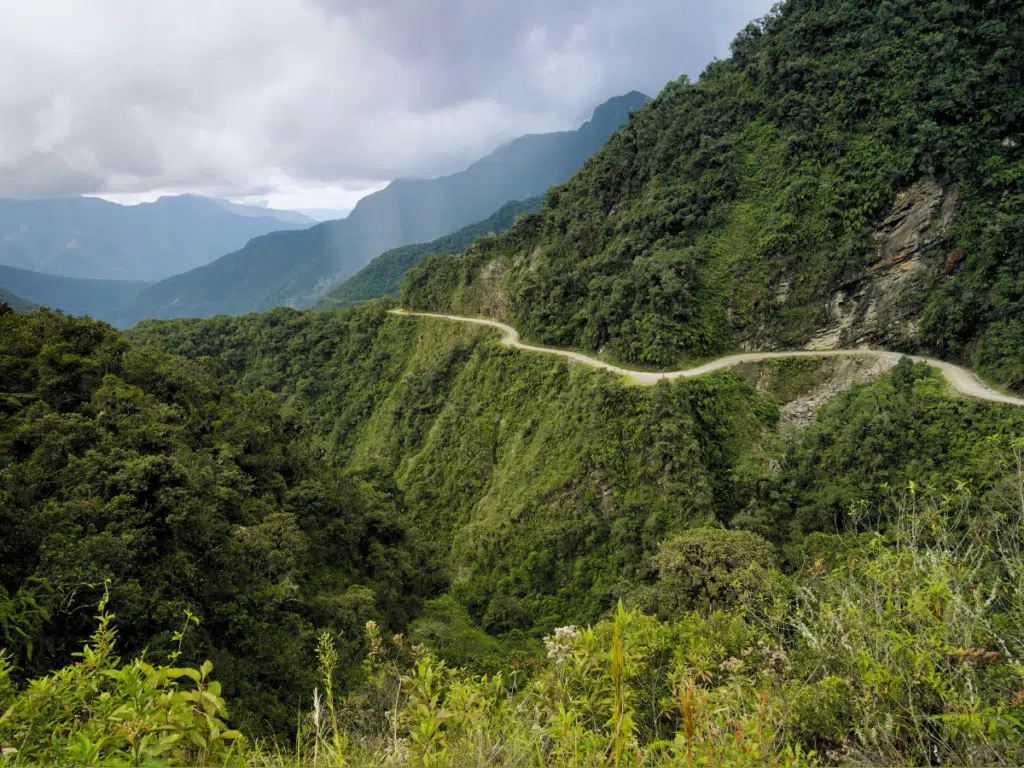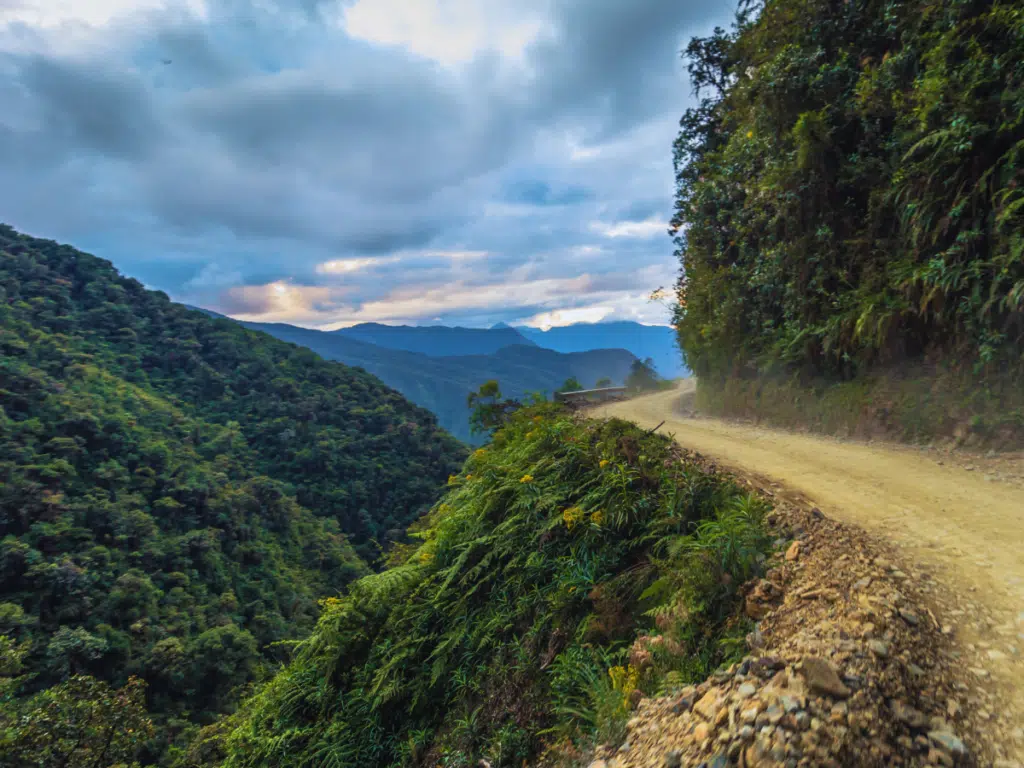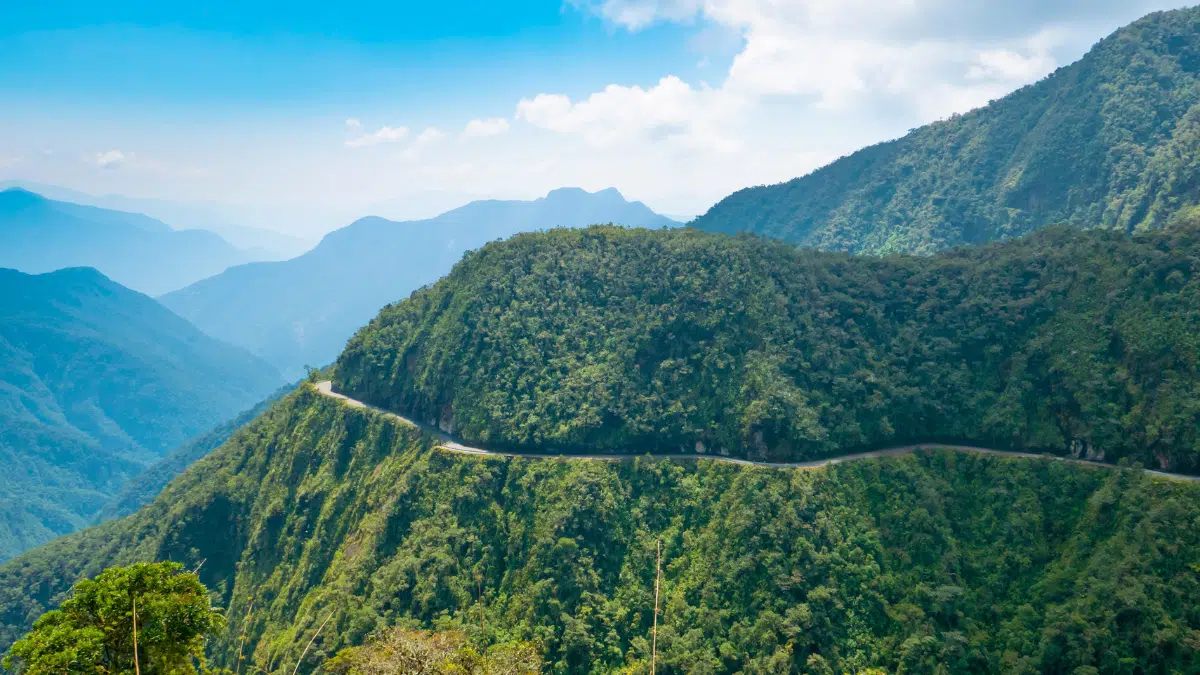Death Road in Bolivia: How to Visit (And Live to Tell The Tale) in 2024
It’s one of the world’s most famous – or infamous – roads, with a reputation so deadly it will make your hair stand on end. At one time, Bolivia’s North Yungas Road, known colloquially as the Death Road, cost 300+ lives every year. So why would anyone want to visit?
Surprisingly, the Death Road in Bolivia is one of the country’s biggest tourist attractions. It welcomes hundreds of visitors every day who journey from La Paz to experience its perilous twists along lush mountainside firsthand, hoping to live to tell the tale.
Crazy enough to plan your own visit to the Bolivia Death Road? This ultimate guide to the North Yungas Road and the popular Death Road biking tours will help you get there.

This post contains affiliate links that may reward me monetarily or otherwise when you use them to make qualifying purchases – at no cost to you. As an Amazon Associate, I earn from qualifying purchases. For more information, please read our disclosure policy.
Death Road Bolivia
The Death Road in Bolivia – formally known as the North Yungas Road – is just as treacherous as it sounds. Photos of dramatic mountain passes with little more than a narrow dirt path carved into them don’t do justice to the drama of experiencing the destination for yourself, where high altitude and bottomless cliffs will take your breath away.
The North Yungas Road connects the Bolivian capital city of La Paz with Coroico, a town on the edge of the Bolivian Amazon Rainforest.
For years, the North Yungas Road was the only route between these two destinations, making the journey a terrifying necessity for locals and travelers alike. The road was first carved into the mountainside in the 1930s by prisoners of war captured from Paraguay, and for decades was one of the few routes from the northern Amazon into the capital city.
Why Is The Death Road Dangerous?
A terrifying combination of factors contributes to this being one of the world’s most dangerous and deadly roads:
- The Death Road is narrow. In reality, it’s a one-lane road, meaning that head-on collisions are possible if drivers aren’t careful. Twists and turns leave little room for error, meaning even one challenging pass alongside another vehicle could send you tumbling over the mountain.
- The Death Road has challenging climate conditions. Frequent rain and fog make visibility a challenge, especially as travelers pass through the temperate rainforest between the Andes and the Amazon.
- The Death Road is steep. La Paz is at a much higher altitude than Coroico, meaning you’ll be sliding down the road non-stop on your journey. Of course, the cliffs and dropoffs along the length of the road are also perilously steep.
- The Death Road has no guardrails. While sections of guard rails have been added to areas of the route over time, there are portions of the route that still lack anything to stop travelers from tumbling down the mountainside.
So why visit a destination known for so much death? It’s a total thrill! Most visitors visit the Death Road on a mountain biking tour from La Paz, where guides accompany participants downhill past the dramatic landscape, lush and beautiful despite how dangerous it can be for visitors.
Is The Death Road The World’s Most Dangerous Road?
While the Death Road in Bolivia is still an extremely dangerous road, changes in recent years have made it considerably less dangerous than it used to be. The Death Road used to take the lives of between 200-300 travelers every year until around 2003, but due to recent upgrades to the road, additional guard rails, and decreased use of the route, that number has dropped precipitously.
However, it is estimated that the Death Road still costs the lives of nearly a dozen people every year. Some of these casualties include travelers visiting the road on the classic Death Road bike tours, so take your tour guides’ advice seriously if you plan to visit!

Death Road Bolivia Accidents
There have been far fewer Death Road Bolivia accidents in recent years than there were more than a decade ago, thanks to some new improvements along the road, including areas with guard rails and new pavement.
Prior to these changes, it wasn’t uncommon for travelers to plunge to their deaths off the mountainside or die in crashes on a frequent, almost daily basis, with around 300 deaths recorded in a year for several years running.
However, the most important factor in decreasing the amount of accidents on the Death Road is due to its decreased use. A new road was built in 2007 connecting Coroico to La Paz. This newer, well-maintained two-lane highway is now the preferred route between these two cities in Bolivia, thereby decreasing traffic on the Death Road significantly.
Read More: La Paz, Bolivia: Ultimate Traveler’s Guide
Is Death Road Still Used?
While the Death Road is now, in many cases, considered obsolete thanks to the newer Cotapata-Santa Bárbara highway, it is still a usable public road that receives a not insignificant amount of traffic. While the newer highway connects most destinations between Coroico and La Paz, there are destinations along the route that are still only accessible via the North Yungas Road.
The Death Road was officially closed to bus and truck traffic after the new road was opened, though cars are welcome to continue to use the Death Road – and many still do.

How to Visit Bolivia’s Death Road
Travelers are free to visit Bolivia’s Death Road with few limitations if they’re looking for a memorable adventure. In fact, the Death Road has long been among the most popular destinations for a day trip from La Paz.
By far, the most popular way to visit the Death Road in Bolivia is by taking a small group day trip departing from La Paz. As this lush yet terrifying road is located in a remote part of the country, almost reaching the Amazon Rainforest, using La Paz as a starting point is almost universally required.
Looking for a recommendation for the best death road biking excursions? These are some of the best in the city (we did the first one!):
- From La Paz: Mountain Biking Experience on Bolivia’s Death Road
- From La Paz: Death Road Biking: Small Group or Private Excursion
Read More: 24+ Best Things To Do in La Paz, Bolivia
Can You Drive On The Death Road?
Visitors can still plan to drive on the Death Road independently. With the increase of “van life” travelers in South America heading to popular Bolivia destinations like the Salar de Uyuni and the Lagunas Route, driving is an increasingly popular way to experience the North Yungas Road as well.
You can rent a car and head towards the Death Road if you are seeking out the experience of driving the Death Road. However, it is important to remember that the rules of the road are different and often not respected in Bolivia. Overall, it’s not an experience we’d recommend – this is one you’ll want to do with a guide showing you the way!

Death Road Bike Tours
Death Road bike tours are the best way to experience Bolivia’s Death Road and are some of the most popular things to do for travelers spending time in La Paz. Day trips include transportation to the start of the Death Road, use of a mountain bike with good suspension and a helmet, a guide to accompany participants along the way, and lunch and use of the facilities at a nearby jungle resort before returning to La Paz.
While the idea of biking down a road renowned for its accidents, tight curves, and lack of guard rails may sound like a bad idea, it’s actually the best way to experience the North Yungas Road.
Bikes allow travelers to take up less precious road space and maneuver more easily among dangerous sections of the road with the support and direction of a guide. This is also an experience that requires the knowledge and guidance of a local, making guided tours a must.
Are Death Road Bike Tours Worth It?
Death Road bike tours, while they might sound intimidating at first, are well worth it! Not only can you say that you survived the Death Road and lived to tell the tale, but you’ll experience one of the most incredible landmarks in South America firsthand.
Despite its imposing history and name, the Death Road is an incredibly beautiful destination. The sweeping mountain vistas as you descend from the heights of the Andes to the lower elevations of the Amazon Rainforest are indescribable. It’s one of the best ways to experience this part of a mostly untouched region of the country.
Death Road Bike Tour Prices
Death Road bike tours generally cost around $90-125 depending on the tour company and the quality of the bike provided. Believe us, this isn’t the time to scrip and save a few dollars to find a cheaper price! You’ll want to go with an experienced tour company that provides mountain bikes with excellent suspension, both for your safety and enjoyment of the experience.
What To Expect
Death Road bike tours generally start early in the morning from La Paz, with a pickup from your hotel or hostel or meeting at the tour office in La Paz. The journey begins from there, with a little over an hour’s ride to the start of the Death Road in Bolivia at La Cumbre.
La Cumbre
From La Cumbre, you’ll be riding a section of paved road all downhill. You’ll later get back in the van to avoid an uphill section until reaching Chuspipata, the start of the traditional section of the road known as the Death Road. Here, a famous sign indicating the start of the Death Road welcomes you with a warning about the road’s history.
Chuspipata
From Chuspipata, the road is gravel, and the occasional mud sections are possible along the downhill grade. However, we had a great experience with the ride and didn’t think it was overwhelming, especially given the good suspension on the mountain bikes provided.
A guide leading the “pack” of bikers and one following up the rear are comforting and don’t push you to go too fast (or too slow), depending on your comfort level.
After The Death Road
As you complete the nearly 40-mile all-downhill ride, you’ll feel that you’ve decreased quite significantly in elevation, noting the temperature warmer and slightly muggier depending on the time of the year you travel.
Tour companies then take bikers to one of several nearby jungle resorts for lunch. You’ll have time to use the facilities like the pool and showers as well, so you’ll want to bring your bathing suit and a change of clothes for the experience.
Plan a Trip to La Paz, Bolivia
Yungas Road Bolivia
Riding a mountain bike down the infamous Death Road in Bolivia might sound like an invitation to insanity, but savvy travelers know it’s an unforgettable adventure in one of Bolivia’s most impressively beautiful regions. If you can overcome your fears – stay as far away as possible from the cliff’s edge! – you’re in for an experience to remember as you navigate down the Death Road.

Carley Rojas Avila is a bilingual New York-based travel writer, editor, content marketer, and the founder of the digital travel publications Explorers Away and Home to Havana. Carley is an expert on all things Latin America, the Caribbean, and Cuba, having lived and worked in four different countries in the region. Her writing has appeared on the Associated Press wires and in Travel + Leisure, Yahoo, MSN, Euronews, The Weather Channel, and more. When she's not writing about her travels, find her front row at a Bad Bunny concert, befriending street cats, and taste-testing every pizza in Havana.

